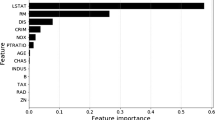Abstract
This article introduces the J-score, a heuristic feature selection technique capable of selecting a useful subset of attributes from a dataset of potential inputs. The utility of the J-score is demonstrated through its application to a dataset containing historical information that may influence the house price index in the United Kingdom. After selecting a subset of features deemed appropriate by the J-score, a predictive model is trained using an artificial neural network. This model is then tested and the results compared with those from an alternative model, built using a subset of features suggested by the Gamma test, a non-linear analysis algorithm that is described. Other control subsets are also used for the assessment of the J-score model quality. The predictive accuracy of the J-score model relative to other models provides evidence that the J-score has good potential for further practical use in a variety of problems in the feature selection domain.
















Similar content being viewed by others
References
Chester DL (1990) Why two hidden layers are better than one? In: Proceedings International Joint Conference on Neural Networks, IJCNN-90-WASH-DC, vol 1, pp265–268
Durrant PJ (2001) winGammaTM: a non-linear data analysis and modelling tool for the investigation of non-linear and chaotic systems with applied techniques for a flood prediction system. PhD Dissertation, Department of Computer Science, Cardiff University
Evans D, Jones AJ (2002) A proof of the gamma test. Proc R Soc Lond Ser A 458(2027):2759–2799
Evans D, Jones AJ, Schmidt WM (2002) Asymptotic moments of near neighbour distance distributions. Proc R Soc Lond Ser A 458(2028):2839–2849
Foster WR, Collopy F, Ungar LH (1992) Neural network forecasting of short, noisy time series. Comput Chem Eng 16(4):293–297
Hornik K (1991) Approximation capabilities of multi-layer feed-forward networks. Neural Networks 4:251–257
Makridakis S, Wheelwright SC, McGee VE (1983) Forecasting: methods and applications, 2nd edn. Wiley, New York
Punch WF, Goodman ED, Pei M, Chia-Sun L, Hovland P, Enbody R (1993) Further research on feature selection and classification using genetic algorithms. In: Proceedings of the fifth international conference on genetic algorithms, Palo Alto. Morgan Kaufmann, San Francisco, pp 557–564
Srinivasan D, Liew AC, Chang CS (1994) A neural network short-term load forecaster. Electric Power Syst Res 28:227–234
Stefánsson A, Koncar N, Jones AJ (1997) A note on the gamma test. Neural Comput Appl 5:131–133
Wilson ID, Paris SD, Ware JA, Jenkins DH (2002) Residential property price time series forecasting with neural networks. Knowl Based Syst 15(5–6):335–341
Wilson ID, Jones AJ, Jenkins DH, Ware JA (2004) Predicting housing value: attribute selection and dependence modelling utilising the gamma test. Adv Econometrics 9:243–275
Zhang G, Patuwo BE, Hu MY (1998) Forecasting with artificial neural networks: the state of the art. Int J Forecast 14(1):35–62
Zhang X (1994) Time series analysis and prediction by neural networks. Optim Method Software 4:151–170
Author information
Authors and Affiliations
Corresponding author
Rights and permissions
About this article
Cite this article
Jarvis, P.S., Wilson, I.D. & Kemp, S.E. The application of a new attribute selection technique to the forecasting of housing value using dependence modelling. Neural Comput & Applic 15, 136–153 (2006). https://doi.org/10.1007/s00521-005-0023-9
Received:
Accepted:
Published:
Issue Date:
DOI: https://doi.org/10.1007/s00521-005-0023-9








